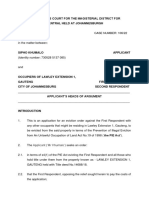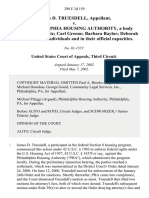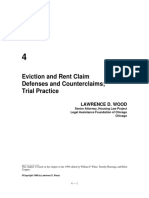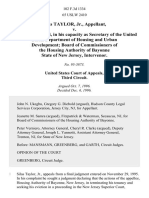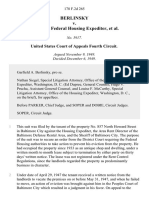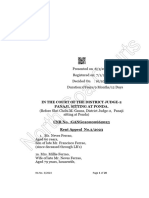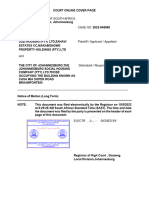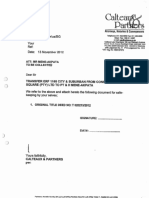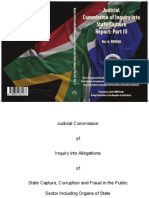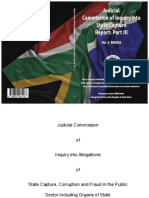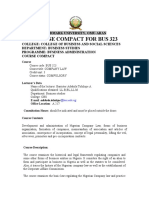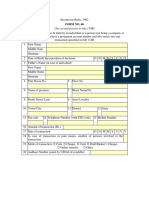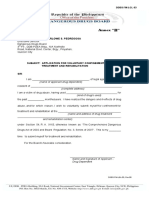adedb320356e4214b0d460943f4a5803adedb320356e4214b0d460943f4a5803-1 015-1
REPUBLIC OF SOUTH AFRICA
IN THE HIGH COURT OF SOUTH AFRICA,
GAUTENG DIVISION, JOHANNESBURG
Case Number:38141/2019
(1) REPORTABLE: YES
(2) OF INTEREST TO OTHER JUDGES: YES
…………………….. ………………………...
7/26/2022
DATE SIGNATURE
In the matter between:
TONY EMMANUEL MEME-AKPTA First Applicant
HLELEN ESIMA MEME-AKPTA Second Applicant
and,
THE UNLAWFUL OCCUPIERS OF ERF 1168,
CITY AND SURBAN, 44 NUGGET STREET,
JOHANNESBURG First Respondent
THE CITY OF JOHANNESBURG METROPOLITAN Second Respondent
_________________________________________________________________________________
JUDGMENT
015-1
�adedb320356e4214b0d460943f4a5803-2
2
015-2
Summary: Prevention of Illegal Evictions and Unlawful Occupation of Land Act 19 of 1998 (‘the
Act’) and the Practice Manual of this Court.The following peremptory procedural prescripts
distilled:
The main application for eviction must be drawn in accordance with the rules of court.
This means that the notice of motion must contain ‘a stated date’ on which it will be
heard.
Service of the main application must be effected in accordance with one of the
appropriate methods prescribed by rule 4, but if these rules for service are inadequate
(which is generally the case in mass evictions) the court must direct that service of all
process, including the main application and the notice in terms of section 4(2), be effected
in a manner which is likely to come to the attention of the occupants of the property.
The application for substituted service is, as is the usual case with such applications,
brought ex parte and is a separate application from both the main application and the
application in terms of section 4(2).
The 4(2) application is a separate application from both the main application and any
application for substituted service and it is brought ex parte. It provides for a second
notification of the date of the hearing of the main application.
The 4(2) application is brought after service of the main application has been effected in
terms of the rules or the order for substituted service.
The facts of each matter will determine the mode of service of the application, the
likelihood of notice coming to the occupants being the decisive factor. Examples of such
modes of service are the sliding of the application under the door of each unit in a block or
the posting of the application at strategic places on an open expanse where dwellings
have been erected or even appropriate daily addresses over a loud hailer for a period of
days as to the date of hearing of the application and where copies may be accessed. There
is a specimen order in the Practice Manual which may provide some guidance.
Legal practitioners who are seeking to serve process in circumstances of mass eviction or
other circumstances where notification of all the occupants could prove challenging must
be astute to these challenges and creative in fashioning suggested methods which are
tailored to the particular facts. In all such instances, the process should properly begin
with an ex parte application for substituted service.
If the method of service adopted under the rules is unlikely to come to the attention of the
occupants, for example service on a person who happens to be found by the sheriff on a
property where a mass eviction is to be undertaken, the risk is run that the court will not
be satisfied with such service when the application for the section 4(2) approval is sought.
This is likely to have the effect that the section 4(2) application will not be granted and
the process will have to be started afresh.
A proper application for eviction duly issued and delivered and the sheriff’s return
evidencing effective service must be before the court when it considers an application for
authorisation under section 4(2).
The hearing date which the section 4(2) notice contains must necessarily coincide with the
hearing date on the notice of motion in the main application and the periods adopted in
the drawing of the process must accommodate this necessity.
015-2
�adedb320356e4214b0d460943f4a5803-3
3
015-3
Whilst the section 4(2) procedure is such that it allows for the providing of further service
mechanisms the need for which have come to light during or since the service of the main
application, such procedure is not intended to be a cure for deficient service of the main
application in the first instance. A court called upon to authorise a notice under section
4(2) will want to be satisfied that all reasonable steps have been taken to obtain proper
service of the main application and mere lip service to rule 4 will not be tolerated.
Service of the main application may result in a notice of intention to oppose being filed
before the authorisation of the notice under section 4(2) in which event the section 4(2)
process may be a formality but is still necessary. The section 4(2) notice, may in such
instance, be delivered to the address provided in the notice of intention to oppose.
In the latter event, care must be taken to determine that the notice of intention to oppose
is the result of all occupants having received notice.
FISHER J:
Introduction
[1] This is an application for the eviction of approximately 200 people from the
various units that they occupy in a block of units situated at 44 Nugget St,
Johannesburg.
[2] The applicants are husband and wife and are the registered owners of the
block. They reside in Nigeria. The first applicant attested, in London, to the founding
affidavit in which it is alleged that the property was acquired for investment purposes.
[3] It is not in dispute that the respondent occupiers have no right to occupy the
property. They pay no rental and no expenses related to the property.
[4] The opposing respondents are represented by Mr Moses Siyabulela
Ncambanca. He indicates that he is authorised to depose to the answering affidavit in
respect of eight households. There are confirmatory affidavits to this effect.
015-3
�adedb320356e4214b0d460943f4a5803-4
4
015-4
[5] In essence, the defence is encapsulated in the following paragraphs of his
answering affidavit.
‘All of the occupiers are poor, many of us desperately so. Many of us have no formal
employment. The average household income in the property is approximately R2800 per
month. The occupiers’ personal circumstances and the lack of suitable alternative
accommodation available to us are set out in more detail below. If we were evicted from the
property, we would, at least in the short term, have no shelter at all. In the medium term we
do not know of any alternative accommodation which is both lawful and affordable to us, and
as a result, we may find ourselves in unlawful occupation of a derelict building.’
[6] Some of the respondents have occupied the property since 2008.
[7] There is no explanation given for the lapse in the bringing of the application
which is close on eight years. But this is not the main problem. The manner in which
the application has been drawn and dealt with procedurally is grossly derelict. It
exhibits a profound lack of appreciation for the importance of compliance with the
legislative scheme enacted under the Prevention of Illegal Eviction and Unlawful
Occupation of Land Act 19 of 1998.
[8] In my experience it is not unusual to be met in these applications with a failure
of process. The scheme provided for by the Act prescribes special and additional
features in applications for eviction of illegal occupants. These prescripts are in
keeping with the recognition of the fundamental constitutional imperatives which an
eviction entails and especially the right to housing in terms of section 26 and all that
this involves.
[9] Whilst these special provisions as to notification and jurisdiction place a
significantly increased burden on landowners seeking eviction of illegal occupiers,
they are necessary to protect the integrity of the eviction process. These measures
are especially important in a country where extreme poverty and homelessness is
endemic.
015-4
�adedb320356e4214b0d460943f4a5803-5
5
015-5
[10] The statutory scheme seeks to provide some balance between the rights of
illegal occupants and landowners in that provided there is compliance with the all the
requirements of section 4 of the Act, the court has no discretion and must grant an
order for the eviction of the unlawful occupier in the event that the occupier offers no
valid defence.
[11] It will help clearly to state and clarify the legal prescripts which a person seeking
an eviction is bound to follow.
Applicable legal prescripts - Eviction of unlawful occupiers
Section 4 of the Act provides for the following peremptory procedure to be followed in
all eviction applications brought under section 4(1) of the Act :
‘ (2) At least 14 days before the hearing of the proceedings contemplated in subsection (1),
the court must serve written and effective notice of the proceedings on the unlawful occupier
and the municipality having jurisdiction.
(3) Subject to the provisions of subsection (2), the procedure for the serving of notices and
filing of papers is as prescribed by the rules of the court in question.
(4) Subject to the provisions of subsection (2), if a court is satisfied that service cannot
conveniently or expeditiously be effected in the manner provided in the rules of the court,
service must be effected in the manner directed by the court: Provided that the court must
consider the rights of the unlawful occupier to receive adequate notice and to defend the case.
(5) The notice of proceedings contemplated in subsection (2) must-
(a) state that proceedings are being instituted in terms of subsection (1) for an order for the
eviction of the unlawful occupier;
(b) indicate on what date and at what time the court will hear the proceedings;
(c) set out the grounds for the proposed eviction; and
(d) state that the unlawful occupier is entitled to appear before the court and defend the
case and, where necessary, has the right to apply for legal aid.
(7) If an unlawful occupier has occupied the land in question for more than six months at the
time when the proceedings are initiated, a court may grant an order for eviction if it is of the
opinion that it is just and equitable to do so, after considering all the relevant circumstances,
including, except where the land is sold in a sale of execution pursuant to a mortgage, whether
015-5
�adedb320356e4214b0d460943f4a5803-6
6
015-6
land has been made available or can reasonably be made available by a municipality or other
organ of state or another land owner for the relocation of the unlawful occupier, and including
the rights and needs of the elderly, children, disabled persons and households headed by
women.
(8) If the court is satisfied that all the requirements of this section have been complied with
and that no valid defence has been raised by the unlawful occupier, it must grant an order for
the eviction of the unlawful occupier, and determine-
(9) In determining a just and equitable date contemplated in subsection (8), the court must
have regard to all relevant factors, including the period the unlawful occupier and his or her
family have resided on the land in question.’
[12] The Practice Manual of this division provides as follows in relation to
applications under the Act:
‘10.9 The application for eviction must be a separate application.
1. The procedure to be adopted (except in urgent applications) is as follows:
1.1. The notice of motion must follow Form 2(a).
1.2. The notice of motion must allow not less than five days from date of service of the
application for delivery of a notice of intention to oppose.
1.3. The notice of motion must give a date when the application will be heard, in the
absence of a notice of intention to oppose.
2. After the eviction application has been served and no notice of intention to oppose has been
delivered or if a notice of intention to oppose has been delivered at a stage when a date for
the hearing of the application has been determined, the applicant may bring an ex parte
interlocutory application authorising a section 4(2) notice and for directions on service. The
eviction application must be in the court file when the ex parte application is brought.
3. When determining a date for the hearing of an eviction application, sufficient time must be
allowed for bringing the ex parte application, for serving the section 4(2) notice and for the 14
days’ notice period to expire. Practitioners must ensure that sufficient time is provided between
the date of the Section 4(2) Notice and the date of hearing of the main eviction application.
015-6
�adedb320356e4214b0d460943f4a5803-7
7
015-7
4. If the eviction application is postponed in open court on a day of which notice in terms of
section 4(2) was duly given, and if the postponement is to a specific date, it will not be
necessary to serve another section 4(2) notice in respect of the latter date.” (Emphasis
added.)
[13] From these provisions the following peremptory procedural rules can be
distilled:
The main application for eviction must be drawn in accordance with the rules of court.
This means that the notice of motion must contain ‘a stated date’ on which it will be
heard.1
Service of the main application must be effected in accordance with one of the
appropriate methods prescribed by rule 4, but if these rules for service are inadequate
(which is generally the case in mass evictions) the court must direct that service of all
process, including the main application and the notice in terms of section 4(2), be
effected in a manner which is likely to come to the attention of the occupants of the
property.
The application for substituted service is, as is the usual case with such applications,
brought ex parte and is a separate application from both the main application and the
application in terms of section 4(2).
The 4(2) application is a separate application from both the main application and any
application for substituted service and it is brought ex parte. It provides for a second
notification of the date of the hearing of the main application.
The 4(2) application is brought after service of the main application has been effected
in terms of the rules or the order for substituted service.
The facts of each matter will determine the mode of service of the application, the
likelihood of notice coming to the occupants being the decisive factor. Examples of
such modes of service are the sliding of the application under the door of each unit in
a block or the posting of the application at strategic places on an open expanse where
dwellings have been erected or even appropriate daily addresses over a loud hailer
for a period of days as to the date of hearing of the application and where copies may
be accessed. There is a specimen order in the Practice Manual which may provide
some guidance.
Legal practitioners who are seeking to serve process in circumstances of mass
eviction or other circumstances where notification of all the occupants could prove
1
See rule 6(5)(b)(iii)
015-7
�adedb320356e4214b0d460943f4a5803-8
8
015-8
challenging must be astute to these challenges and creative in fashioning suggested
methods which are tailored to the particular facts. In all such instances the process
should properly begin with an ex parte application for substituted service.
If the method of service adopted under the rules is unlikely to come to the attention of
the occupants, for example service on a person who happens to be found by the sheriff
on a property where a mass eviction is to be undertaken, the risk is run that the court
will not be satisfied with such service when the application for the section 4(2) approval
is sought. This is likely to have the effect that the section 4(2) application will not be
granted and the process will have to be started afresh.
A proper application for eviction duly issued and delivered and the sheriff’s return
evidencing effective service must be before the court when it considers an application
for authorisation under section 4(2).
The hearing date which the section 4(2) notice contains must necessarily coincide with
the hearing date on the notice of motion in the main application and the periods
adopted in the drawing of the process must accommodate this necessity.
Whilst the section 4(2) procedure is such that it allows for the providing of
further service mechanisms the need for which have come to light during or
since the service of the main application, such procedure is not intended to be
a cure for deficient service of the main application in the first instance. A court
called upon to authorise a notice under section 4(2) will want to be satisfied
that all reasonable steps have been taken to obtain proper service of the main
application and mere lip service to rule 4 will not be tolerated.
Service of the main application may result in a notice of intention to oppose being filed
before the authorisation of the notice under section 4(2) in which event the section 4(2)
process may be a formality but is still necessary. The section 4(2) notice, may in such
instance, be delivered to the address provided in the notice of intention to oppose.
In the latter event, care must be taken to determine that the notice of intention to
oppose is the result of all occupants having received notice.
[14] The procedure adopted in this application is an example of either a profound
misunderstanding of these rules of process or a deliberate disregard for such process.
I turn to deal with the application.
015-8
�adedb320356e4214b0d460943f4a5803-9
9
015-9
The application for eviction
[15] This application was of the type that cried out for substituted service. Although
there was an appreciation for this as emerges from the manner in which the notice of
motion was framed, no such service was ever effected.
[16] The notice of motion comprises two parts. Part A constitutes an ex-parte
application for substituted service which entails the sheriff sliding a copy of the
application under the door of each unit, alternatively affixing a copy thereof to the door
of each room that appears to be occupied or if there is no door by placing a copy
thereof inside the room. Part B is the main eviction application.
[17] Part B does not state a date for the hearing of the main application. Instead it
notifies that the application “will be made on a date which you will be advised of in a
notice of set-down incorporating the provisions of Section 4(2) of [the Act], which will
be served on you.”
[18] This omission is, without more, fatal to the application and it should not be
entertained. Indeed the registrar is not empowered to issue such an application in the
absence of a stated date for appearance on the notice of motion. This notwithstanding,
the unopposed motion court is often faced with such inchoate process. The notice of
motion is then followed by a notice of set down which is apparently meant to cure this
illegality. What is envisaged is that a respondent may be faced with notice of process
but given no means to appear and deal with it. This is an untenable position, especially
in the context of evictions.
[19] This omission is enough. But there is more. It emerges from the return of
service of the eviction application that it was served on 05 November 2019 by ‘affixing’
at the property which is described in as a ‘chosen domicilium’ of the occupants. Clearly
this is a nonsense. The occupiers have no leases and there is no basis on which a
domicilium address could have been chosen be any of them.
015-9
�adedb320356e4214b0d460943f4a5803-10
10
015-10
[20] Then on 09 December 2019 - i.e. three days after this ‘service’ and
presumably pursuant thereto - an application was made in the unopposed court for an
extraordinary hybrid order having the following features:
i. It sought to authorise a section 4(2) order in terms of an annexure
marked A.
ii. It provided that in the event that the sheriff was unable to serve the
notice in terms of section 4(2) ‘timeously or at all or should the date for
final hearing change for any reason from that reflected in annexure A …
the date of hearing reflected in the Notice may be amended accordingly
and endorsed by the Registrar… prior to service.’
[21] Pursuant to this application an order in these terms was granted by van der
Walt JA. The annexure A purportedly approved under section 4(2) has the following
curious features:
i. It is, in the first instance, addressed to the occupiers and purports to
notify them that the applicant intends to make application on 18
February 2020 for an order evicting them.
ii. In the second instance, it is addressed to the sheriff and directs that:
a. the sheriff serve the application on the second
respondent – i.e. the municipality (but presumably
intended to refer to the occupants) by displaying the notice
and all further processes and notices at the entrance of
the property including any order of court and by affixing
such documents to the units occupied, alternatively
sliding a copy thereof under the door of such units;
b. the sheriff attempt to establish the names of the occupiers
of each and every room who are prepared to identify
themselves;
c. the sheriff serve the application on any person present at
the property and explain the nature and importance of the
015-10
�adedb320356e4214b0d460943f4a5803-11
11
015-11
relief sought by the applicants in English and/or Sotho
and/or Zulu; and
d. that the sheriff’s return in respect of the notice must
specifically state that each of the above directions was
carried out.
[22] The application sans date is reflected in a return filed as having been served
on the Municipality on 11 December 2019. This is the only evidence of any service of
any process on the Municipality on file.
[23] Returns reflecting service of the section 4(2) notice and a notice of set down
as follows are filed of record:
i. service of the section 4(2) notice on 19 February 2020 ‘upon Ms pretty
at the main door’ who is reflected as ‘the lady who sells sweets at the
door and being in control of the property;
ii. service of the section 4(2) notice and a notice of set down ( for hearing
on 28 April 2021) on 07 April 2021 ‘upon Lind Kula the Committee
Member… in control of and at the place of business of’ the occupants.
A further note in the return reads ‘Note: situated at 117, the service took
place at the main entrance.’
[24] A section 4(2) notice with the original date of 18 February 2020 deleted in
manuscript and replaced with the date ‘ 06-05-2020’ is filed of record.
[25] Thus presumably, on each occasion that a new date for hearing was obtained,
the date of the original 4(2) notice was changed to accommodate the set down. Whilst
this may be in accordance with the order granted by van der Walt JA it is not in
accordance with the procedure laid down in the Act and the Practice Manual.
[26] These deficiencies in service notwithstanding, the process made its way to the
knowledge of some of the occupants.
015-11
�adedb320356e4214b0d460943f4a5803-12
12
015-12
[27] There was a notice of intention to oppose filed by these occupants. It has been
made clear in the answering affidavits filed that this opposition is by only eight
households in the block.
[28] These occupants represented by Mr Ncambanca who was assisted by an
organization known as the Inner City Foundation assisted Mr Ncambanca in filing a
notice of intention to oppose. The notice of opposition was delivered by way of email
on behalf of the opposing occupiers.
[29] It seems that this opposition was received by the applicants attorneys as a
stroke of luck. They have, on the basis that the application is opposed attempted to
conduct the matter as if this opposition by some occupants serves to forgive the
significantly irregular process. It does not.
[30] Firstly, there is no basis upon which a court may be called on to determine an
application in the face of such unbridled failure of process and in the absence of any
application for condonation ( and I express no opinion as to whether such condonation
would be competent under the Act).
[31] Secondly, the matter was opposed by only some of the occupants. There are
other occupants who have not been served in terms of the provisions of the Act or the
rules. Notwithstanding that there was, in terms of part A of the main application, an
acknowledgment that there needed to be substituted service of the application, there
is no order filed in relation to Part A. As I have said, the only return of service in respect
of the main application is one which reflects service on the building by attachment on
the basis that it is a chosen domicilium address. Which it could not be. It seems that
Part A of the notice of motion was never moved for.
[32] Furthermore, although it emerges from the eccentric section 4(2) notice that
such notice on its terms directs substituted service thereof by the sheriff, there is no
return filed which shows that this has been done.
[33] As if this gross dereliction of attention to process were not enough, reference
to the merits also shows deficiencies which impact on the manner in which this court
is able to decide the case. I move to deal with these merits.
015-12
�adedb320356e4214b0d460943f4a5803-13
13
015-13
The merits
[34] An important aspect of a decision to evict is the determination of a just and
equitable date for eviction. In this determination the court must have regard to all
relevant factors, including the period the unlawful occupier and his or her family have
resided in the property.
[35] Many of the occupants in this case have lived in the building for more than a
decade. It is an imperative of the process that this residency be explored and
explained.
[36] There was no explanation as to how it has come about that some of the
occupants have lived in their units for more than a decade. There is even less said
about why, notwithstanding the fact that the property was purchased by the applicants
in 2011, it took more than eight years for the application to be brought.
[37] At the hearing, the court made inquiries as to these procedural and substantive
deficiencies. It was sought also that the original transfer documents be provided. The
application was postponed to allow for such supplementation.
[38] The original transfer documents were ultimately provided. There was, however,
no information provided as to the lengthy periods that the occupants had variously
occupied the units in the building and there was no explanation as to the close on eight
years which has passed between the purchase of the building and the application for
eviction.
[39] In terms of section 4(7), the question of whether it is just and equitable to order
eviction must be decided ‘after considering all the relevant circumstances, including,
whether land has been made available or can reasonably be made available by a
municipality or other organ of state or another land owner for the relocation of the
unlawful occupier, and including the rights and needs of the elderly, children, disabled
persons and households headed by women.’
015-13
�adedb320356e4214b0d460943f4a5803-14
14
015-14
[40] The municipality is a critical party in any eviction application of this nature.
Municipalities have obligations to intervene to deal with potential homelessness in the
areas in which they operate.
[41] As I have said, the only evidence of service of the eviction application on the
Municipality is service of an application on 11 December 2019 which provides that
the application will be heard on a date to be determined by the Registrar. There is
furthermore no evidence of any service of set down on the Municipality.
[42] The failure to properly serve a meaningful application on the Municipality
means that the Municipality has been unable to comply with its statutory function in
relation to the merits of the application – which includes providing information to the
court as to whether land has been made available or can reasonably be made
available by a municipality or other organ of state or another landowner for the
relocation of the unlawful occupier.
[43] In sum, the notice of motion in the main application was defective for being
contrary to the Act. There was, furthermore, no proper service of the application on
either the occupants or the Municipality.
Conclusion
[44] The unashamed disregard for the Act and the Practice Manual in this matter is
regrettable. The deficiencies are so marked that it is difficult to believe them to be
attributable to a mere lack of understanding.
[45] The Act enacts the constitutional provisions relating to homelessness and the
right to housing. It recognises that eviction from one’s home entails more than resort
to the common law and that it can only be achieved by following the statutory process
set out in the Act. People subject to an eviction from their home are generally of the
most vulnerable in any society. It is for this reason that the Act has been enacted. It
015-14
�adedb320356e4214b0d460943f4a5803-15
15
015-15
provides special constitutional protections for people facing eviction. If these are not
afforded illegal occupiers an eviction order may not be granted.
[46] As this application is fundamentally flawed both procedurally and on the merits.
It falls to be dismissed.
Order
[47] I thus make the following order:
The application is dismissed.
_____________________________
FISHER J 7/26/2022
HIGH COURT JUDGE
GAUTENG DIVISION, JOHANNESBURG
Date of hearing: 13 April 2022, matter was then postponed sine die for delivery of
further documents.
Delivery of all further documents: 05 July 2022
Judgment delivered: 26 July 2022.
015-15
�adedb320356e4214b0d460943f4a5803-16
16
015-16
APPEARANCES:
For the Applicants Adv C.N Nhlapho.
Instructed by: Sithi and Thabela Attorneys.
For the Respondents: The opposing respondents were in person.
015-16

















